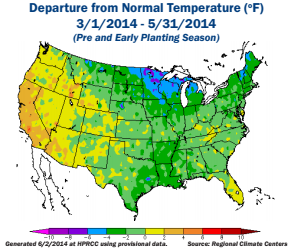A. Planting and Early Growth Conditions – Spring (March – May)
Cold spring, rain in the north decreased early planting
Weather factors impacting corn yield and quality include the amount of precipitation and the temperature just prior to and during the corn-growing season. These weather factors interact with the corn variety planted and the soil fertility. Grain yield is a function of the number of plants per acre, the number of kernels per plant, and the weight of each kernel. Cold or wet weather at planting could reduce plant numbers, or hinder plant growth, which may result in lower yields. Some dryness at planting and early growth time is beneficial, as it promotes a deeper root system to access water later in the season.
Overall, for the key corn-growing areas in 2014, a cold spring led to a less than average amount of April planting. However, May had warm, dry weather, resulting in 30% of the corn planted in one week, thereby returning planting progress to the long-term average. Only a few areas with excessive rain had poor emergence due to the soil crusting over, making it difficult for the corn shoot to push through.
More specifically, the majority of the Gulf and the Pacific Northwest ECAs experienced a cold spring, with additional planting delays from abundant rainfall in the northern states. Therefore, most farmers had to wait until May for the soil to dry out enough to plant. However, this delay allowed for the soil to warm up quickly and led to excellent, uniform emergence, and rapid early growth.
The Southern Rail ECA had an average to cool spring, but continued to have below average precipitation. This dry weather allowed planting and emergence progress to be close to the historical average.
